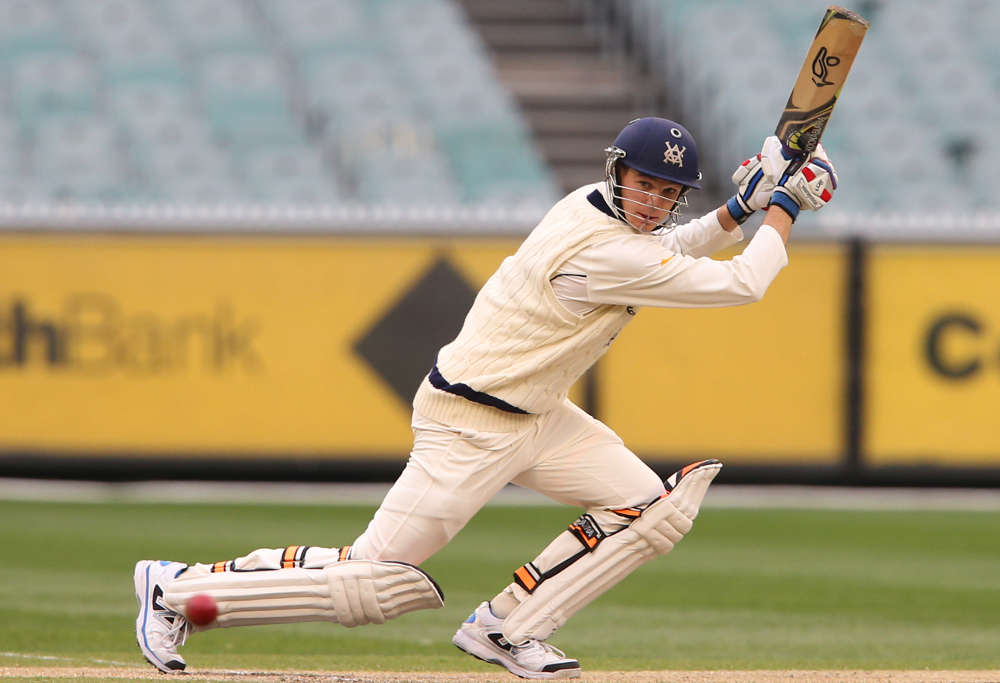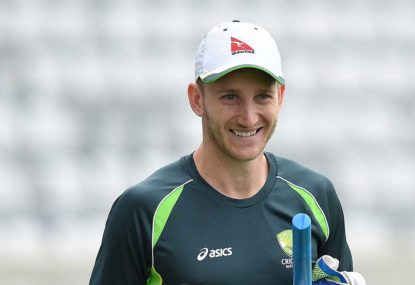Australian selector Rod Marsh’s suggestion that batting ability helped Joe Mennie earn selection in the Test squad prompted dismay among Australian cricket fans.
But the selectors are right to be concerned about Australia’s short batting line-up, particularly ahead of two heavyweight Test series in the next year against teams with serious batting depth in India and England.
The selectors’ mistake, in this instance, was thinking about bolstering Australia’s lower order before strengthening its middle. Right now, opposition teams must feel that when they have Australia three down they are just one wicket away from busting their batting line-up wide open.
The opposite is true of teams who face England, for example. England’s top six is a mess, leading to them regularly being four down for not many in recent times. But, unlike Australia, England have heavy batting talent from seven through nine in their order.
So pronounced is this lower order strength that England’s two best-performing partnerships in Test cricket this year have been those for their sixth and seventh wickets
Right now, England’s first-choice bowling attack in non-Asian conditions (fitness permitting) would be James Anderson, Stuart Broad, Chris Woakes, Moeen Ali and Ben Stokes.
So England have the option of batting at eight and nine two players in Moeen (Test batting average 34) and Woakes (35) who have far better batting records than Australia’s six (Mitch Marsh, average 24) and seven (Peter Nevill, average 21).
At seven, England have a wicketkeeper-batsman in Jonny Bairstow who is the leading runscorer in Tests this year with 1118 runs at 66.
While the Ashes is still a year away and Australia have many important Tests to play before them, this disparity in batting depth is a concern.
In the shorter term, Australia will arrive in India in just over three months to face a team which also has a much longer batting line-up. Ravindra Jadeja has a first-class batting average of 44 yet he likely will bat at eight, followed at nine by paceman Bhuvneshwar Kumar, who averages 24 with the bat in Tests.
Meanwhile, keeper Wriddhiman Saha has averaged 38 with the blade since taking over from the retired MS Dhoni.
The selectors will be mindful of the long batting line-ups of India and England when they are picking the Australian XI for those two series. This should put even greater focus on the batting of Marsh and Nevill this summer.
Nevill deserves to be under heavy scrutiny. While his glovework has been neat in his 15 Tests, he cannot survive while averaging only 21 with the blade. This is particularly relevant if Australia persist with Mitch Marsh.
If that pair don’t significantly increase their batting output Australia will be left at huge disadvantage against not just India and England, but also this summer against South Africa and Pakistan, both of whom have strength at 6 and 7. Nevill and Marsh are fortunate that their competitors in domestic cricket have not been dominating.
Nevill’s strongest challenger, in the eyes of the selectors, may well be ODI ‘keeper Matthew Wade. The Victorian remains an ordinary gloveman, but the selectors clearly rate him and they could be seduced by his batting if Nevill cannot find some runs against South Africa.
Wade averaged 35 with the bat in his 12 Tests and scored two tons. The left hander has been in fine touch in ODIs, with 326 runs at of 41 in his past dozen matches, and started the Shield season well with 78 and 26 against Tasmania.

If Australia wanted to go down England’s route of picking a keeper based on his batting ability over his glovework, they could consider Victoria’s Peter Handscomb or Western Australia’s Cameron Bancroft. Bancroft’s teammate Sam Whiteman is the best long-term keeping option thanks to his tidy glovework and significant talent with the bat.
As for Marsh, he has managed to keep his spot, in part, because there haven’t been many batting all-rounders flourishing in State cricket. Glenn Maxwell has a fantastic first-class record but suffers from concerns about his cavalier batting approach and the fact that he spins the ball the same direction as Lyon.
NSW all-rounder Moises Henriques was parachuted into the Test team in Sri Lanka and duly flopped. The best alternative to Marsh, in my opinion, would be Victorian Marcus Stoinis.
Over the past two years, Stoinis has blossomed as a batsman, making 1700 runs at 45 in first-class cricket. He also has excelled for Australia A in the past year, making 252 runs at 50, and taking seven wickets at 26 in his four matches – two against South Africa A at home, and two against India A in Chennai last year.
Admittedly, his career first-class bowling record of 24 wickets at 49 doesn’t scream “all-rounder”. Stoinis has, however, improved significantly as a bowler in the past 18 months.
He was Victoria’s leading wicket taker in the just-completed Matador Cup, snaring nine wickets at 26. He also bowled well in this year’s Indian Premier League, taking eight wickets at an average of 18 from seven games for Kings XI Punjab.
Stoinis is known as a confident player of spin, with former Australian batsman David Hussey recently describing him in the media as “very good” against tweakers. With the tour of India looming large, that could work in Stoinis’ favour and put pressure on Marsh.
Australia’s middle order batting has been a significant weakness for some time now, even when playing at home, due to the ineffectiveness of Marsh and Nevill. The series against South Africa could well decide their short-term futures in the baggy green.






























































































